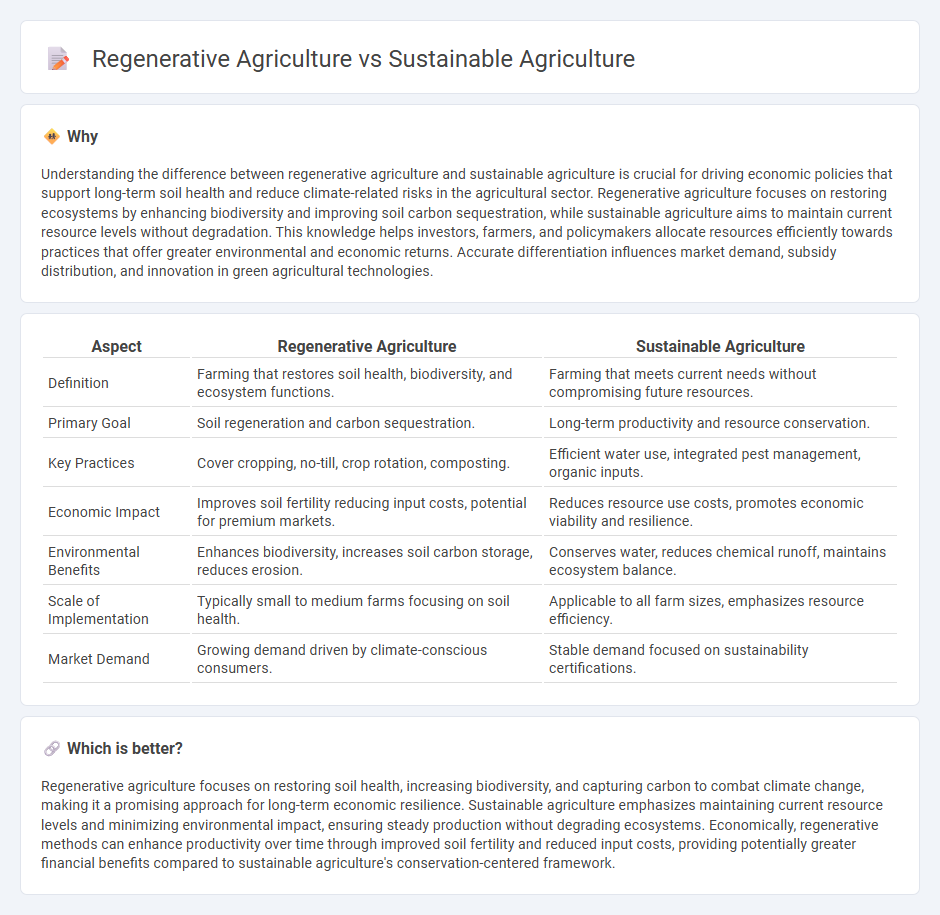
Regenerative agriculture focuses on restoring soil health, increasing biodiversity, and capturing carbon to create resilient farming systems that enhance long-term productivity. Sustainable agriculture aims to meet current food needs without compromising environmental quality or the ability of future generations to produce food. Explore the key differences and economic impacts between these approaches to better understand their role in shaping the future of agriculture.
Why it is important
Understanding the difference between regenerative agriculture and sustainable agriculture is crucial for driving economic policies that support long-term soil health and reduce climate-related risks in the agricultural sector. Regenerative agriculture focuses on restoring ecosystems by enhancing biodiversity and improving soil carbon sequestration, while sustainable agriculture aims to maintain current resource levels without degradation. This knowledge helps investors, farmers, and policymakers allocate resources efficiently towards practices that offer greater environmental and economic returns. Accurate differentiation influences market demand, subsidy distribution, and innovation in green agricultural technologies.
Comparison Table
| Aspect | Regenerative Agriculture | Sustainable Agriculture |
|---|---|---|
| Definition | Farming that restores soil health, biodiversity, and ecosystem functions. | Farming that meets current needs without compromising future resources. |
| Primary Goal | Soil regeneration and carbon sequestration. | Long-term productivity and resource conservation. |
| Key Practices | Cover cropping, no-till, crop rotation, composting. | Efficient water use, integrated pest management, organic inputs. |
| Economic Impact | Improves soil fertility reducing input costs, potential for premium markets. | Reduces resource use costs, promotes economic viability and resilience. |
| Environmental Benefits | Enhances biodiversity, increases soil carbon storage, reduces erosion. | Conserves water, reduces chemical runoff, maintains ecosystem balance. |
| Scale of Implementation | Typically small to medium farms focusing on soil health. | Applicable to all farm sizes, emphasizes resource efficiency. |
| Market Demand | Growing demand driven by climate-conscious consumers. | Stable demand focused on sustainability certifications. |
Which is better?
Regenerative agriculture focuses on restoring soil health, increasing biodiversity, and capturing carbon to combat climate change, making it a promising approach for long-term economic resilience. Sustainable agriculture emphasizes maintaining current resource levels and minimizing environmental impact, ensuring steady production without degrading ecosystems. Economically, regenerative methods can enhance productivity over time through improved soil fertility and reduced input costs, providing potentially greater financial benefits compared to sustainable agriculture's conservation-centered framework.
Connection
Regenerative agriculture and sustainable agriculture share core principles aimed at preserving soil health, enhancing biodiversity, and reducing environmental impact. Both practices focus on long-term productivity by minimizing chemical inputs and promoting natural ecosystem cycles. Implementing these approaches improves carbon sequestration and resilience against climate change, directly benefiting economic stability in agricultural sectors.
Key Terms
Resource Efficiency
Sustainable agriculture emphasizes minimizing environmental impact through efficient use of water, nutrients, and energy to maintain productivity without depleting natural resources. Regenerative agriculture goes further by enhancing soil health, increasing biodiversity, and restoring ecosystem functions while improving resource cycling and carbon sequestration. Explore how these approaches optimize resource efficiency for long-term agricultural resilience and environmental benefits.
Value Chain Integration
Sustainable agriculture emphasizes minimizing environmental impact and maintaining resource efficiency throughout the value chain, while regenerative agriculture actively restores soil health and biodiversity, creating a more resilient and productive system. Value Chain Integration in regenerative agriculture involves close collaboration among farmers, suppliers, processors, and distributors to ensure ecological practices are upheld at every stage, enhancing product quality and marketability. Explore the benefits of integrating value chains in regenerative agriculture to drive both environmental and economic sustainability.
Ecological Capital
Sustainable agriculture prioritizes maintaining ecological capital by minimizing resource depletion and pollution, ensuring long-term farm productivity. Regenerative agriculture goes further by actively restoring soil health, increasing biodiversity, and enhancing ecosystem services to rebuild ecological capital beyond its original state. Explore how these approaches transform agricultural practices and contribute to environmental resilience.
Source and External Links
Sustainable agriculture - Sustainable agriculture is farming that meets current food and textile needs without compromising future generations, using environmentally friendly methods that protect soil, water, and biodiversity while addressing climate change and social concerns.
Sustainable agriculture: definition, principles and benefits - Sustainable agriculture balances three pillars--economic profit, environmental protection, and social well-being--to ensure long-term farm viability, reduce environmental footprint, and improve conditions for farmers and communities.
What is Sustainable Agriculture? - Sustainable agriculture focuses on maintaining healthy, living soils through techniques like cover cropping, reduced tillage, and maximizing natural inputs to promote biological systems that reduce reliance on harmful chemical inputs.
 dowidth.com
dowidth.com